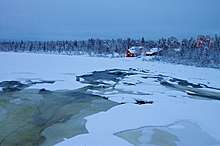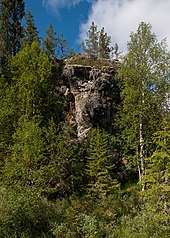Muonio
Muonio is a municipality in Finnish Lapland. Most visitors head to the main destinations: 🌍 Pallas-Yllästunturi National Park or 🌍 Olostunturi ski resort.
Understand
.jpg)
Standing by an important salmon river, Muonionjoki, the area has been inhabited for at least 7,000 years. The meaning of the name Muonio is unknown but probably of Sami origin. It appears first in manuscripts from mid 16th century and in a Swedish map from 17th century in forms Monanisk kyla, Mononiske or Muniosuij. The original name of the municipality was Muonionniska ("top of the rapids of Muonio[river]") which was abbreviated into its current form in 1923. There is notable amount of ancient holy places of the Sami people in the municipality.
Being inhabited by the Sámi for ages, the first mention of Finnish landownership in Muonio is from 1575, actually before the Crown of Sweden had taken the lands into its ownership, which officially happened in 1584. From the early 1600s Muonio area was administered from Pajala (in present Sweden) until 1812 when the newborn borderline between the kingdom of Sweden and the Russian Empire made Muonio an independent parish.
In the World War II aftermath known as the Lapland War the destruction was somewhat complete; well over 80% of all buildings were destroyed by retreating German troops. For example in the main village only the church and a few storehouses were saved.
For some decades Muonio has been one of the places where international car manufacturers test their new car models in harsh winter conditions. The proving grounds are vast but hidden in the forests. This business is shrouded in the utmost secrecy, but it provides a significant source of income to this small community.
Muonio has about 2,300 permanent residents, about half of them living in the main village. Like many other municipalities in Finnish Lapland, present day Muonio lives mostly from tourism. This was heavily boosted in late 1990s by shifting the municipality border so that the Pallastunturi fells became part of Muonio instead of Kittilä.
The municipality is unilingually Finnish even though the northernmost villages have names also in Northern Sami. English is widely understood. Like in the other municipalities in the Muonionjoki-Tornionjoki river valley – both sides the border – the local Finnish dialect is distinctive.
Get in

By plane
The nearest airports are in Kittilä to the southeast, Hetta to the northeast, and in Pajala southwest across the border to Sweden. Rovaniemi airport is farther away but with much better connections, especially off season. There are coach connections at least from Rovaniemi and Kittilä airports.
By train
The nearest railway stations are at Kolari and Rovaniemi. There is a direct coach connection to Muonio from the night train, which arrives 11:05 am in Rovaniemi.
By bus
There are a few daily coach connections from Rovaniemi and Oulu. The ticket costs €50–70/adult from Oulu and around €45/adult from Rovaniemi. The trip takes about 3½ hours from Rovaniemi.
By car
Muonio village is located in the crossroads of road E8 and Finnish national road 79. Olostunturi skiing resort is located by the road 79 some 8 km from the village and the Finnish road 957 to Pallastunturi area departs road 79 about 12 km from the main village.
If you arrive from Sweden turning away from Swedish national road 99 to road 404 in Muodoslompolo will take you to 🌍 Muonio border crossing. The customs office is on the Finnish side of the border.
Get around
There is no local public transportation in Muonio. You may use local taxi or the long distance coaches. Check Matkahuolto for the time tables. Taxi Tapio Hietalahti (phone: +358 40 039 9113, e-mail: muoniokt@hotmail.com) operates a shared taxi on the route Muonio-Olos-Jeris-Pallas-Kittilä airport. The shared taxi must be invoked at least 24 hours before the trip.
See
- The midnight sun is visible from May 25th until July 19th in the Muonio village. The polar night starts at December 10th and lasts for 24 days. During the winter the northern lights can be seen most nights if the sky is clear.
- 🌍 Muonio church, Kirkkotie 4. A wooden church built in 1817 and was saved in Lapland War. The service is held every Sunday at 11:00.
- 🌍
Muonio local history museum, Lahenrannantie 51, ☏ +358 40 489 5110. June-August: Tu-Sa 11:00-17:00. Local history museum in the 19th century buildings which are brought here from other villages around. Open only during the summer.
.jpg) Keimiöniemi fishing huts
Keimiöniemi fishing huts - 🌍 Keimiöniemi fishing huts (Keimiönniemen kalakentät), Keimiöniementie. Lake Jerisjärvi is famous for its fish and Keimiöniemi has served as a fishermen's base at least since 1500's. The oldest existing huts were built in 1700's and they are still private property. The site is included to the list of nationally significant built cultural environments. free.
- 🌍 Ylimuonio village. The northernmost agricultural village in the Tornionjoki-Muonionjoki river valley. Luckily the village stayed almost untouched in the Lapland War and is therefore a rare example of pre-war village architecture in Finnish Lapland. On the list of nationally significant built cultural environments.
- 🌍 Pallastunturi visitor centre, Pallastunturintie 557 (32 km from the centre), ☏ +358 20-639-7930, ✉ pallastunturi@metsa.fi. 09:00–16:00/17:00. The Pallas-Yllästunturi National Park is the most visited national park in Finland. During the peak season there are daily bus connections from Muonio and Kolari villages to the Hotel Pallas and the visitor centre. Check Matkahuolto for details. free.
- 🌍 Taivaskero fell. The highest peak of the Pallastunturi fell massif rises up to 807 meters a.s.l. The Olympic Torch for the 1952 Summer Olympics was lighted here. There is a hiking trail from the Hotel Pallas and the Pallastunturi visitor centre. free.
- 🌍 Särkitunturi fell. Considered one of the most scenic places in Finland. There is a parking lot by the road and a hiking trail to the top. Climbing the fell takes about an hour and you probably want to stay up there more than just one hour... At the top there is a maintained campfire site and a number of small ponds suitable for swimming.
- 🌍
Pakasaivo lake, Pakasaivontie (80 km from the Muonio centre, 25 km from Äkäslompolo village). Also known as Hell of Lapland. In the Sami mythology saivo is a lake that acts as a portal to another world and is therefore a holy place. Scientifically Pakasaivo is a meromictic lake; under the relatively thin surface layer the water becomes acidic and lacks oxygen. The exact depth of the lake is unknown but it is at least 60 meters deep. The nearly circular northern end is actually a huge giant's kettle. There is a parking lot with campfire site a few hundred meters from the lake but the nearest bus stop is 13 km away. The road to the lake is not maintained in winter. free.
 Seitapahta
Seitapahta - 🌍 Kirkkopahta sieidi and Valkeajoki hut, Pakasaivontie (3 km from Pakasaivo lake). Kirkkopahta is a big stone in the forest. Acted as a sieidi it is a holy place for the Sami people. The Valkeajoki hut was used by timbers and is renovated into a museum. The hut has free entry and there is no staff present. Making a fire to the stove is forbidden. By the way, the spring behind the hut is radioactive. free.
- 🌍 Äkäsaivo lake and Seitapahta sieidi, Aakenuksentie. Another holy saivo lake. From the road 9403 (Aakenuksentie) there is a 3 km long circular trail to the site. If you use your imagination a bit you can see a human face in the huge Seitapahta stone. By the lake there is a shelter and a campfire site. free.
- 🌍 Äkäsmylly and Äkäslinkka rapids, Äkäslompolontie 1380, ✉ info@akasmylly.fi. An old mill by the rapids. The mill was used by locals until 1960s. The café is open during the summer season. A 3.5 km long trail takes you to a human-faced sieidi stone by the lake. If you are heading to the trail using wellies might be a good idea.
Do
.jpg)
Most visitors come here to enjoy the nature, some come for downhill skiing or fishing. There isn't real nightlife in the skiing resorts at Olos and Pallas.
Buy
- 🌍 K-Market Muoniontori, Lahenrannantie 7, ☏ +358 16 533 200. M-F 08:00-21:00, Sa 08:00-20:00, Su 11:00-19:00. Groceries. Mail service.
- 🌍 S-Market Muonio, Puthaanrannantie 4, ☏ +358 44 788 4990. M-Sa 08:00-22:00, Su 10:00-21:00. Groceries. Gasoline.
- 🌍 Alko Muonio, Lahenrannantie 1. M-F 09:00-21:00, Sa 09:00-18:00, Su closed. Alcoholic beverages.
Eat
- HyväPata, Torniontie 110 (1 km south from the centre, by E8), ☏ +358 16 532-505, ✉ hyvapata@gmail.com. M–F 10:00–18:00, lunch 11:00–15:00. Meals, coffee and snacks. sandwiches €4–6, hamburgers €8–13, pizzas €9–13, lunch €9–11, other meals €16–19.
- Silk Coffee Shop, Kilpisjärventie 15 (in the north part of the centre, by E8), ☏ +358 40-187-2497. M–F 10:00–18:00, Sa–Su 12:00–18:00 ; lunch M–F 11:00–15:00. Thai food, some meals with a local touch. Souvenirs. €8–16, lunch €11.50.
Drink
- Swiss Cafe Konditoria, Puthaanrannantie 5 (in the centre), ☏ +358 40-354-8333. daily 10:00–17:00. Swiss café with souvenir shop.
Sleep
- 🌍 Lapland Hotel Pallas, Pallastunturintie 560, ☏ +358 16 323 355, ✉ pallas@laplandhotels.com. The oldest fell resort in Finland and perhaps one of the most peculiar ones as the hotel is located at the treeline! The original building was destroyed completely by Germans during the Lapland War but the resort was rebuilt after the war. Restaurant. Downhill skiing pistes, off-piste skiing, entrance to the national park.
- 🌍 Lapland Hotel Olos, Oloshotellintie 25, ☏ +358 16 536 111, ✉ olos@laplandhotels.com. Skiing resort which is closed during the summer. Three restaurants. Gym.
- 🌍 Toras-Sieppi, Torassiepintie 212, ☏ +358 40 170 1925, ✉ sales@harriniva.fi. Cabin village and caravan park at a 19th-century reindeer farm by the lake of same name. Aurora domes. Husky, reindeer and horse activities. Restaurant.
- 🌍 Hotel Jeris, Jerisjärventie 91, ☏ +358 400 177 600, ✉ sales@harriniva.fi. December-April. Aurora domes. Various saunas. Restaurant. Pub.
- 🌍 Hotel Harriniva, Harrinivantie 35, ☏ +358 400 155 100, ✉ sales@harriniva.fi. Hotel. Camping. Restaurant. Pub.
- 🌍 Lomamaja Pekonen, Lahenrannantie 10 (in the centre), ☏ +358 40 550 8436, ✉ info@lomamajapekonen.fi. Apartments, huts (summer only) and caravan places.
- 🌍 River Caravan, Muoniontie 1733 (in Sonkamuotka), ☏ +358 40 707 9843, ✉ info@lapinlomamokit.fi. June 1st-September 30th. Camping and caravan by the river Muonionjoki. area fee €27.
Connect
Go next
| Routes through Muonio |
| Turku ← Oulu ← | S |
→ Kilpisjärvi → Tromsø |
| Rovaniemi ← Kittilä ← | S |
→ END |
| Muodoslompolo ← | W |
→ END |